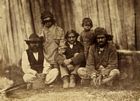- Born
- 15 November 1823
Paris, France - Died
- 27 April 1861
Yokohama, Japan - Occupation
- Photographer, Traveller and writer
Antoine Julien Fauchery was born in Paris on 15 November 1823. He spent his early years trying his hand as an architect and a painter, before establishing himself as a writer with the popular journal Le Corsaire-Satan. At this time, he formed a close friendship with Nadar, the greatest of the early French photographers. He associated with a number of prominent writers in the bohemian circle of Théodore de Banville, Henry Mürger, Champfleury, Charles Baudelaire, and Gérard de Nerval. In fact, he was immortalised in Mürger’s Scènes de la Vie de Bohème on which Puccini’s opera La Bohème was based since, according to de Banville, the author had used Fauchery as the model for the character of the painter Marcel.
Submitting to the call of adventure, Fauchery set out in July 1852 for Melbourne in the hope of making his fortune on the Victorian goldfields. After nearly two fruitless years in Ballarat, he returned to Melbourne to open the Café Estaminet Francais, a well patronised restaurant where Europeans gathered. He returned to France in 1856, his Lettres d’un Mineur en Australie a series of fifteen letters recounting his experience in Australia appeared in instalments in the Parisian newspaper Le Moniteur Universel in January and February 1857. They were published as a book later in 1857 in Paris by Poulet Malassis et de Broise.
Later in 1857, Fauchery was commissioned by the French Government to return to Melbourne with the purpose of reporting his impressions of Australia. He established himself in Collins Street, Melbourne and advertised his skills in the new art of photography. Shortly after, his professional collaboration began with Richard Daintree. Together they planned to produce for sale a series of photographs in ten monthly instalments consisting of views of life in Victoria and the notable members of the community. These were advertised as ‘Sun Pictures of Victoria’, using the new collodion wet-plate process. Their different backgrounds – Fauchery the artist, and Daintree the geologist - combined to produce remarkably high-quality images so early in the history of photography, providing a rare and invaluable record of life in Victoria in the late 1850s. Only three sets – all slightly different – of these photographs are known to exist today: one in the State Library of Victoria, and the other two in the State Library of Queensland.
Fauchery sailed from Melbourne for Manila in 1859, and then visited China in 1860, recording in his serialised ‘Lettres de Chine’ his first-hand account of the ‘Arrow War’ and the sacking of the Summer Palace. He left for Japan in 1861 where he died at Yokohama on 27 April 1861.



